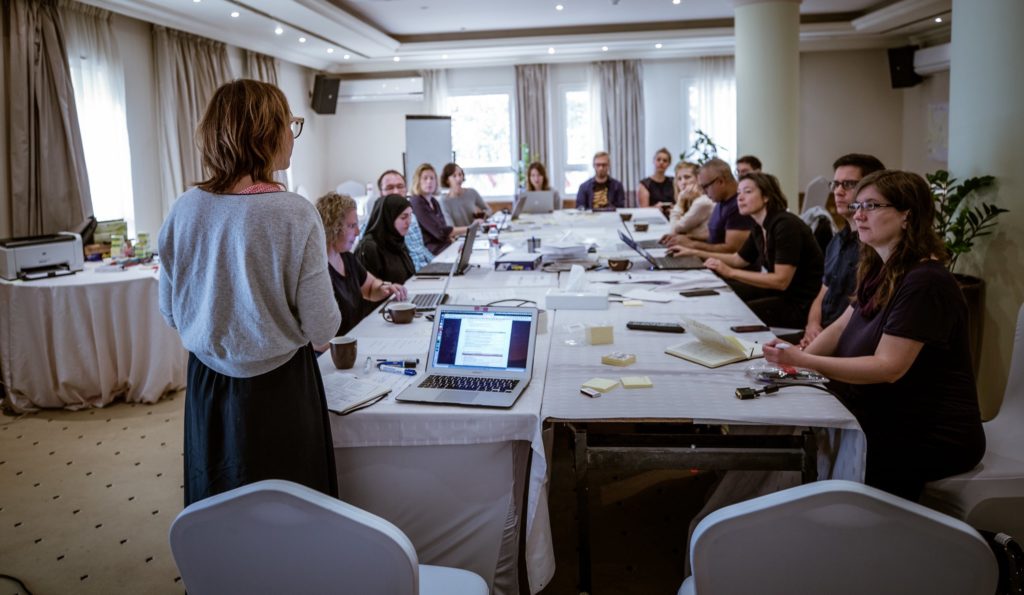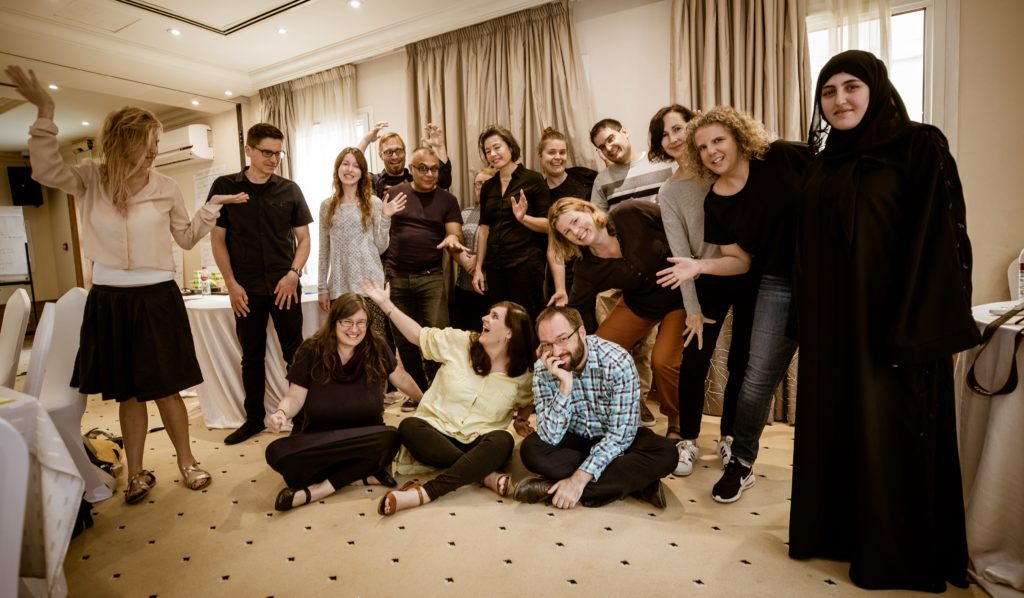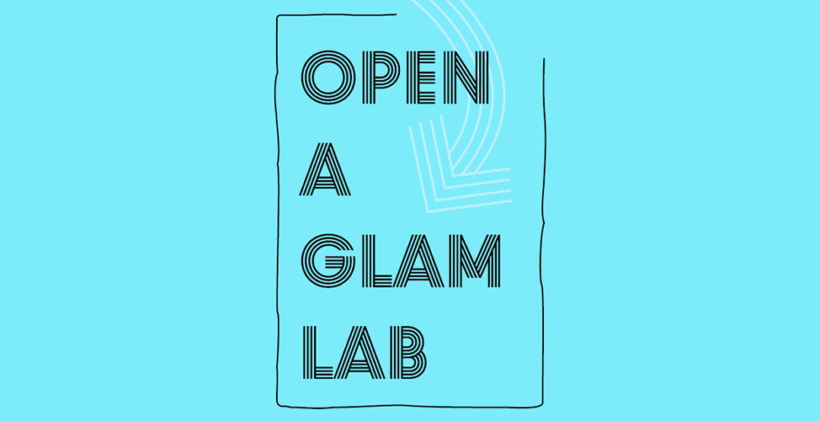In late September 2019 a group of 16 digital cultural heritage practitioners working in and with Galleries, Libraries, Archives and Museums (GLAM) innovation Labs arrived in Doha to write a book in 5 days!

Following a BookSprint methodology, 16 members of the International GLAM Labs Community spent one very long sleep deprived and highly caffeinated week authoring a book capturing the community’s knowledge, wisdom and experience on establishing and running GLAM Labs. Led by the Manager of British Library Labs Mahendra Mahey, and with significant financial and logistical support from UCL Qatar, Qatar University and the extremely hardworking Milena Dobreva, the group collectively found its voice and produced this book!
The book is the culmination of 12 months of grassroots community building effort largely thanks to the unwavering commitment of Mahendra Mahey. Its launch on Wednesday 30 October represents a defining moment in the GLAM Labs community journey. Formed some 12 months beforehand at a British Library global Library Labs event in London, the group quickly grew in representation to include museums, galleries, archives, and digital humanists from all over the world. So much so that a year later, on 21 September 2019, sixteen of us arrived in Doha with a mandate from the wider GLAM Labs community to write this book. The task was daunting but, supported by our institutions and cheered on via Twitter and WhatsApp, we never felt alone. There are several blogs already written about the intense journey we undertook during this week, so I wont go over old ground (you can find links to the blogs on our glamlabs.io website). Instead I want to reflect on the importance of this book at a critical moment in the evolution of a highly skilled community of GLAM practitioners and change-makers. As one of these practitioners, and fellow booksprinter Abbey Potter from the Library of Congress Labs articulates in her blog,
Labs help transform the future ways in which knowledge and culture are disseminated….GLAMS are full of people who are passionate about connecting collections to communities; Labs provide opportunities to combine new ideas with the deep expertise of existing staff and a mechanism to imagine and test future possibilities.
Museum technologist Chad Weinard refers to the slow pace of change in GLAMs and the cultural clash between innovation and museums. Whether it is infrastructure or practice you are trying the change, the innovation mantra of ‘Move fast and break things’ is anathema to GLAM culture. And indeed, Labs offer a clear and collaborative way forward for organisations as they ‘experiment, collaborate, take risks, sometimes fail, and always push boundaries.’ (Open a GLAM Lab p.32). Arguably, then, our sector needs skilled communities of practice like ours and generous institutional support to foster more collaborations, experimentation, promote sharing and embrace risk if we are to effectively imagine future possibilities for our institutions.

The GLAM Labs community imagined a future for itself; a future where its knowledge, expertise, learnings, failures and passion for the sector was openly available to everyone. This book, then, became our northstar project, our biggest experimental risk; the culmination of all of our collective work in Labs across Europe, America, Australia, UK, and Qatar. It seemed impossible when the idea was first floated, to bring a group of international peers to one location for 5 days to write a book that contributed to the building of better more sustainable Labs for the future of GLAMs. But again, Mahendra’s leadership steered us through. And here is the crucial point about the true significance of this book and the International GLAM Labs Community— it demonstrates quite clearly the need for good leadership (at all levels) of our institutions and our communities of practice to make change happen. No doubt the writings and ‘thoughts in progress’ of one of the museum sectors brightest minds (and Labs pioneer) Seb Chan, Chief Experience Officer, ACMI, Melbourne, will be known to many of you. Earlier this year Seb wrote on the need for sector leadership grounded in passion, expertise and optimism:
In these times of austerity or where the ‘reality of the situation’ feels impossible to make change, it is the leader’s role to not let go of the collective imagination — the ‘collective possible’. Possibility matters, but impossibility is what often inspires effort and new ideas…Without northstar projects and a sense of excitement, you wont get anywhere. It boils down to passion, expertise and optimism.
Our Labs community has galvanised around the leadership of Mahendra, whose passion, expertise, optimism (and lots of hard work) ultimately provided us with the opportunity and the voice to write this book. Not wanting to squander the momentum, we now have European, American, African and Australian nodes of the community; we have a website (sponsored by the Interaction Consortium, Sydney, Australia); we have a mailing list, slack channel and WhatsApp group; and we have plans to foster international collaborations, knowledge exchanges, and mentoring programs around the world. Not bad for a grass roots initiative with no funding or governance structures of its own — just the passion, expertise and optimism of the collective. (Of course none of this would be possible without the generous support of each of our home institutions and the continued belief in the value of Labs practice to the future of our organisations).

There were moments during the writing of this book where, ever conscious of a propensity for navel-gazing, we paused to remind ourselves of who we were writing for. The exercise was fascinating and far from straight forward. We wanted a book that helped GLAM directors understand the need for Labs and the practical value of experimentation, and embracing risk and failure in a contemporary institutional setting. We also wanted a book that served as a ready guide for staff setting up a new Lab or sustaining an existing one — to share all our past mistakes and successes so as not to reinvent the wheel. But we were also mindful of writing for people like us, passionate GLAM workers experimenting at the edges of traditional practice, pushing boundaries and challenging hierarchies and structures that traditionally mediate access to knowledge and culture. Serendipitously, on the eve of leaving Adelaide for Doha I was buoyed by a Twitter thread that articulated the value of the Labs community for me. Michael Peter Edson of Museum of the United Nations — UN Live , another museum thought leader you should follow closely, tweeted that to promote and sustain individual and organisational changes in practice, sometimes we needed to remember to ‘preach to the choir’.
Some reasons why you need to preach to the choir #sharecarex:
– Convince practitioners that they’re doing the right thing, thinking strong thoughts, not going crazy
– Arm practitioners w most recent thinking/knowledge
– Strengthen the network (more resilience)
– …— Michael Peter Edson (@mpedson) September 17, 2019
… Of course, this isn’t a license to become repetitive or stagnant, but “the choir” evolves; includes people whose jobs are in flux, learning, changing, & have varying levels of power commitment to the issues. Lots of actors needed to push across “the chasm” 😉 /#sharecarex pic.twitter.com/il7XpY2z9I
— Michael Peter Edson (@mpedson) September 17, 2019
If I may borrow from Michael’s and Seb’s reflections on leadership, I think we all have a responsibility to be the change we want to see in our sector. We can all lead in small ways and we can always choose to generously share our knowledge and be open to learning from others. The Labs community is my ‘choir’ and it is a valuable and enriching process when we sometimes preach to ourselves. It challenges us and helps us to grow as practitioners and as a community. Communities of practice can be beacons of light amongst the oft encountered institutional malaise of “we’ve always done it this way”. And ours is a shining example of 21st century collaborative cultural leadership that will continue to grow and evolve along with the sector as a whole.
It would be remiss of me to not acknowledge that boundary pushing and challenging institutional norms often comes from a place of privilege, and we all need to own that. Koven Smith reflected on this recently after a Twitter discussion around bravery, risk aversion and hand-slapping flared up. The precarity of sector employment, the risk adverse nature of large established institutions and the privilege inherent in acts of bravery and experimentation all call for the types of supportive communities of practice we are building through the GLAM Labs community.
The establishment of my own Lab here in South Australia — the North Terrace Cultural Precinct’s Collab — has benefited enormously from the generosity of the wider Labs community. When I met Mahendra in late September 2018 in Adelaide at the Digital Humanities Australasia 2018 conference we clicked immediately. His energy and passion for collaboration and community building matched my own. After I’d presented on our emerging South Australian innovation Lab we arranged to meet over breakfast later in the week to discuss Labs. Over 3 hours later (and *maybe* multiple serves of breakfast) we’d excitedly exchanged ideas, thoughts, learnings, successes and failures about our library and museum worlds and the role an inclusive GLAM Labs community could play in amplifying and supporting the work we do and the impact we strive to make. So I join the burgeoning Labs community….I’d found my people! They were welcoming, collaborative, generous, experimental, risk taking, and platform agnostic, and above all they really cared about cultural heritage. We use all sorts of tools and technologies to connect virtually with each other at all times of the day (for Aussies like me, that usually means midnight Zoom meetings and 156 WhatsApp notifications delivered to my phone overnight). But the passion and generosity of this community to openly share their highs and lows is what sustains me.
The GLAM Labs community is a force for good, and those of us privileged enough to spend that long week together in Doha have formed bonds that will benefit our institutions for years to come. The book, collaboratively written over 5 days by 16 sleep deprived GLAM professionals, will never be perfect. It will continue to evolve as will our community of practice. The book is experimental in its construction (BookSprint), it is open in its publication (public domain), and it is generous with its institutional knowledge. To again quote Seb Chan, this time on the particular value of this book:
GLAM Labs have been the catalyst for significant structural change in the last decade and their ability to scale up or down as buffeted by winds of financial uncertainty has been an unlikely source of their resilience. This book is an essential read for cultural institution leaders looking to understand why their organisation might need a GLAM Lab, and also for those workers who are making the case for one. Each chapter clearly lays out the reasoning, benefits, challenges, and ways forward and the case studies are clear and compelling. I look forward to a further blossoming of Labs in our sector.
But more than simply heralding a further blossoming of Labs in our sector, I hope that this book and the community behind it sparks new conversations and collaborations around cultural heritage practice that we can all learn from, and that more of you reach out and help us continue to diversify and grow representation of the GLAM Labs community. We need you!
*The original post was authored by Dr Kristy Kokegei on Medium, 4 November 2019.
